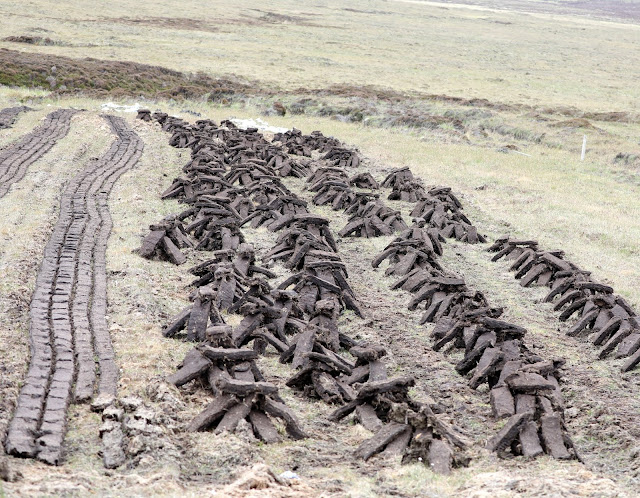Friday May 24
Yesterday, we had no newspaper. Someone's on strike, Bayhead Stores said. To-day was back to 10.30 a.m normal - except for Saturdays when 5.30 p.m. is normal and Sundays when none are delivered. They come to Benbecula by plane during the week - they were the ones on strike yesterday - and to Lochmaddy by boat on Saturday. Saturday's boat doesn't get in until after 4 p.m. No plane nor boat on Sundays. One gets used to it.......
The last day is always difficult. The need not to drive too far nor too long because of to-morrow's journey. Sorting the car packing and the house to-night as we have to leave soon after 6 a.m. in the morning to drive to Lochmaddy for the 6.45 latest check-in. And the evening meal which was a Co-op microwave special.
We started with a last drive to Aird an Runair. our first bird on entering the reserve road was a female Hen Harrier. I couldn't get a photo as an approching car flashed for Pam to continue !!
I wanted a photo of a Corn Bunting for my year folder. We'd heard them several times in the dunes but not had a photo opportunity. One duly obliged, although choosing to 'sing' from a lump of dune behind a tussock of grass.
The bay looked lovely, even under a leaden sky. The white shell sand was devoid of seaweed and therefore the birds that feed on the insects the rotting weed attracts.
Committee Road set us off early with a Golden Eagle hovering over the ridge, shades of last night. Our intention was to stop over the brow, within sight of Sollen and to use our Emperor Moth lure again. In the passing place we found Sue and Ian parked so they joined us in the fun. As soon as Pam got out with the lure, the first male arrived, soon to be joined by another in a frantic fluttering frenzy around the areas where the lure had touched. How frustrating for them.
This time's visit to Baleshare took us across the causeway all the way to the extensive beach, where two Motorhomes were already parked on the shingle.
Baleshare (Scottish Gaelic: Baile Sear) is a flat tidal island in the Outer Hebrides of Scotland.
Baleshare lies to the south-west of North Uist. Its economics and community were boosted by the building of a causeway in 1962. The 350 m (380 yd) causeway was built by William Tawse Ltd. The island is extremely flat by Hebridean standards, rising to only 12 metres (39 feet) above sea level and known for its long sandy beach. It has a population of 49 living in two settlements: Samhla and Teananachar.
The name means 'east farm' or 'east town'. The 'west town' may have been on land that was said to exist to the west of Baleshare, washed away in the sixteenth century, over which it was possible to walk to the Monach Islands at low tide The Monachs are some 15 kilometres (9.3 miles) to the west. Another story suggests there was once a land bridge to Kirkibost, 100 metres (330 feet) to the north.
Two prehistoric settlements have been uncovered, which contain the remains of a circular stone house and pieces of pottery, bone and metal. In common with other sites in the area, they are threatened by coastal erosion.
Using my telescope, I scanned the extensive bay for seabirds finding two superb Great Northern Divers in full summer plumage, a few Cormorants and Shags, one Gannet and little else. Occasional glimmers of the sun made patches of water appear to dance with iridescent, sparkling, vertical jumps.
I became aware that an unkown voice was breaking into my reverie. An older, beanie hatted lady, was peering up at me from the beach below. She was asking for the identity of a bird she'd seen at the water's edge. On this occasion, the description was good enough for me to give her a confident answer. Turnstone. With a nod and no word of thanks she walked away...... to a motorhome.
A large flock of Scottish Greylags took noisy honking flight. These seem to be truly wild, slim and wary versions of our farmyard waddlers.
Lapwing chicks are beginning to appear. The most wayward of young, they run at birth and their parents are constantly trying to keep track of them. Stopping to try and find one, we heard a near Corncrake. With a little patience, this bird actually came into view well enough to encourage camera use, even though it was through a wire fence. A fast passing van made it lower its head and leg it back into the Iris bed.
We completed the Paibles round trip, finding a female Hen Harrier hunting again. Probably the same one as we saw this morning. We also found two more summering Whooper Swans, this ones discoloured neck a tribute to the peaty water in which it dips to feed on the grasses.
Back to chores. This is the only place where we are expected to strip the beds before we leave. I'll do that in the morning of course.
Ian and Sue kindly came round after 6 to help carry luggage to the car and to lift it into the boot. Much appreciated. What good friends they are.
Only one moth in the trap this morning. None of us could identify it with 100% certainty so I sent a photo to Richard. Glaucous Shears was the very quick response. Not our first, but there must be a lot of variation in this species.



































